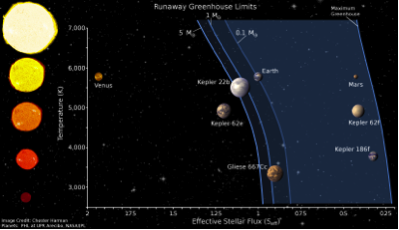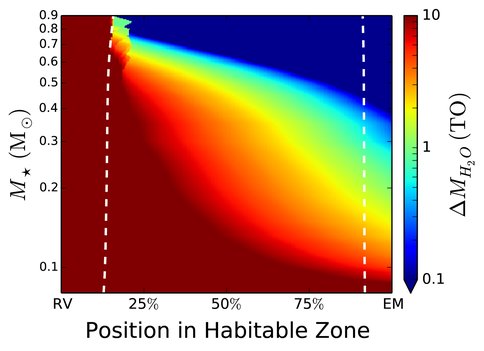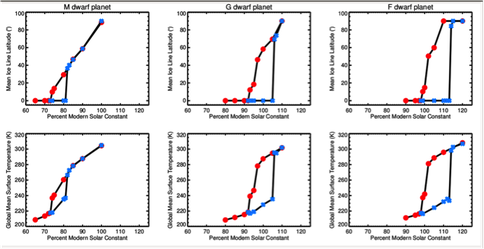2014 Annual Science Report
 VPL at University of Washington
Reporting | SEP 2013 – DEC 2014
VPL at University of Washington
Reporting | SEP 2013 – DEC 2014
Stellar Effects on Planetary Habitability and the Limits of the Habitable Zone
Project Summary
In this task, VPL team members studied the interaction between stellar radiation (including light) and planetary atmospheres to better understand the limits of planetary habitability and the effects of stellar radiation on planetary evolution. Work this year included using climate models to recalculate the boundaries of the surface liquid water habitable zone planets of different masses, an exploration of the effect of a star’s spectrum on the rate at which a planet can exit a snowball state, and calculation of water loss from terrestrial planets with different fractions of atmospheric carbon dioxide. Atmospheric escape models were also used to illustrate how the pre-main sequence evolution of M-dwarf stars could strip the gaseous envelopes from mini-Neptune planets, transforming them into potentially-habitable, Earth-sized rocky bodies. In pioneering work, VPL researchers also showed that the pre-main sequence phase of an M-dwarf can lead to strong atmospheric escape of water on otherwise potentially habitable worlds, potentially rendering them uninhabitable. Observational work was also undertaken to characterize the frequency and characteristics of stellar flares on M dwarf stars from Kepler data, as input to future work on characterizing the effect of stellar flares on habitability.
Project Progress
In this task, VPL team members studied the interaction between stellar spectral energy distribution (SED) and planetary atmospheres to better understand the limits of planetary habitability and the effects of stellar radiation on planetary evolution. Work this year used climate models for recalculation of the habitable zone boundaries for planets of different masses, an exploration of the effect of a star’s SED on the rate at which it can exit a snowball state, and calculation of water loss from terrestrial planets with different fractions of CO2 in their atmospheres. Atmospheric escape models were also used to illustrate how the pre-main sequence evolution of M-dwarfs could strip the gaseous envelopes from mini-Neptunes, transforming them into potentially-habitable, Earth-sized rocky bodies. In pioneering work, VPL researchers also showed that the pre-main sequence phase of an M-dwarf can lead to strong atmospheric escape of water on otherwise potentially habitable worlds, a result that has important implications for the search for habitable worlds using transit transmission. Work was also undertaken to characterize the frequency and characteristics of stellar flares on M dwarf stars from the Kepler data. These data will feed into future work on characterizing the effect of stellar flares on habitability.
The Limits of the Habitable Zone
To explore the effect of planetary mass on the limits of the habitable zone, VPL Team members Kopparapu, Ramirez, Kasting, Domagal-Goldman et al. used their existing climate model and scaled the background N2 atmospheric pressure with the radius of the planet (based on the assumption that smaller planets will have less dense atmospheres). Perhaps counter-intuitively, they found that the inner edge of the HZ (runaway greenhouse limit) moves outward (~10% lower than Earth flux) for low mass planets due to larger greenhouse effect arising from the increased H2O column depth. For larger planets, the H2O column depth is smaller, and higher temperatures are needed before water vapor completely dominates the outgoing longwave radiation. Hence the inner edge moves inward (~7% higher than Earth’s flux). The outer HZ changes little due to the competing effects of the greenhouse effect and an increase in albedo (Kopparapu et al., 2014).
Kopparapu and Domagal-Goldman also collaborated with Stephen Kane from San Francisco State University, to determine the occurrence rate of potential Venus analogs from Kepler data. They have defined a “Venus Zone”, closer to the star than the HZ, in which the planet is more likely to be a Venus analog rather than an Earth analog. To perform a consistent comparison with the occurrence rate of Earth-size planets in the HZ (eta_Earth), they have used the same Kepler data available from the published literature, and identified 43 potential Venus analogs. They calculated an occurrence rate of 0.32 (+0.05, -0.07) for M-dwarfs, and 0.45 (+0.06, -0.09) for GK dwarfs for potential Venus analogs. In comparison, the eta_Earth for M-dwarfs currently ranges between 0.4 to 0.5, and 0.22 for GK-dwarfs.
Wordsworth and Pierrehumbert undertook a range of calculations to explore water photolysis and hydrogen loss for terrestrial exoplanets. They found that CO2 can only cause significant water loss by increasing surface temperatures over a narrow range of conditions, with cooling of the middle and upper atmosphere acting as a bottleneck on escape in other circumstances. Around G-stars, efficient loss only occurs on planets with intermediate CO2 atmospheric partial pressures (0.1-1 bar) that receive a net flux close to the critical runaway greenhouse limit. In contrast, for a CO2-rich early Venus, diffusion limits on water loss are only important if clouds caused strong cooling. Around M-stars, water loss is primarily a function of orbital distance, with planets that absorb less flux than ~270 W m-2 (global mean) unlikely to lose more than one Earth ocean of H2O over their lifetimes unless they lose all their atmospheric N2/CO2 early on. Because of the variability of H2O delivery during accretion, their results suggest that many “Earth-like” exoplanets in the habitable zone may have ocean-covered surfaces, stable CO2/H2O-rich atmospheres, and high mean surface temperatures.
Shields and collaborators continued to explore the effect on planetary climate and habitability of interactions between the spectral energy distribution (SED) of a host star and an orbiting planet’s atmosphere and surface. Simulations using a three-dimensional (3-D) global climate model (GCM) showed that a planet’s exit out of global ice cover was sensitive to host star SED (Fig. 3). A planet orbiting an M-dwarf star exhibited a smaller resistance to melting out of a frozen state, requiring a smaller stellar flux to initiate deglaciation than planets orbiting hotter, brighter stars (Shields et al. 2014). This is due to the higher absorption of near-infrared radiation by ice on the surfaces and greenhouse gases and clouds in the atmosphere of an M-dwarf planet. These results, along with the results from previous work simulating the entrance into snowball states as a function of host star SED (Shields et al. 2013) indicated that given their greater climate stability, planets orbiting cooler, lower-mass stars that acquire habitable conditions may be the best candidates for long-term habitability and life beyond the Solar System.
Stellar Radiation and Planetary Evolution
Also addressing planetary evolution and implications for habitability, Luger, Barnes, Meadows and collaborators investigated the evolution of mini-Neptunes in the habitable zones of M dwarfs (Luger et al. 2015). They found that vigorous atmospheric escape during the pre-main sequence phase of the host star can strip low mass mini-Neptunes of their gaseous envelopes, transforming them into Earth-size rocky/icy bodies which could evolve to become habitable. Luger and Barnes further showed that the pre-main sequence phase of M dwarfs can also lead to vigorous atmospheric escape from terrestrial planets in the habitable zone (Luger and Barnes 2015). Because of the star’s high luminosity early on, terrestrial planets may experience prolonged runaway greenhouses, during which water vapor photolysis and hydrogen escape to space can desiccate their surfaces, potentially rendering them uninhabitable (Fig. 2). This process can also lead to the buildup of large quantities of abiotic oxygen in their atmospheres, which could mimic the presence of a biosphere (see the Project Report on Astronomical Biosignatures for more detail on this aspect of the research).
Living with a Flaring Star
To better understand the frequency and characteristics of stellar flare activity on M dwarf stars, Hawley led research using Kepler data to study the time-dependent behavior of flares. In an initial study, short-cadence observations of Kepler M dwarfs were used in conjunction with ground-based observations to identify a subset of the most active M dwarf stars. Single and complex flares were studied, and complex flares were found to most likely be a temporal superposition of several flares rather than a different phenomenon, supporting a scenario where many independent activity areas on the stellar surface contribute to the observed flare rate (Hawley et al., 2014). In a companion paper, Kepler observations of the M4 dwarf star GJ1243 were used to study the dependence of flare energy as a function of time for a wide dynamic range of flare amplitudes (Davenport et al., 2014). This study found that the majority of flares of different sizes behave similarly and a template for flare temporal behavior was developed. These observational studies will be used as input to future work planned on the effect of stellar activity on planetary habitability for planets orbiting M dwarf stars.
Davenport, J.R.A., and 14 colleagues (2014) Kepler Flares. II. The Temporal Morphology of White-light Flares on GJ 1243. The Astrophysical Journal 797, 122.10.1088/0004-637X/797/2/122
Hawley, S.L., Davenport, J.R.A., Kowalski, A.F., Wisniewski, J.P., Hebb, L.,
Deitrick, R., Hilton, E.~J. (2014). Kepler Flares. I. Active and Inactive M Dwarfs. The Astrophysical Journal 797, 121. 10.1088/0004-637X/797/2/121
Kopparapu, R.; Ramirez, R.; Schottlekotte, J.; Kasting, J. F.; Domagal-Goldman, S.; Eymet, V. 2014. Habitable Zones Around Main-sequence Stars: Dependence on Planetary Mass, Astrophysical Journal Letters, 787, L29
Shields, A. L., Bitz, C. M., Meadows, V. S., Joshi, M. M., Robinson, T. D. 2014 Spectrum- driven Planetary Deglaciation Due to Increases in Stellar Luminosity, Astrophysical Journal Letters, 785, 9.
Luger, R., Barnes, R., Lopez, E., Fortney, J., Jackson, B., and Meadows, V. (2015) Habitable evaporated cores: transforming mini-Neptunes into super-Earths in the habitable zones of M dwarfs. Astrobiology 15:57–88.
Luger, R. and Barnes, R. (2015) Extreme water loss and abiotic O2 buildup on planets throughout the habitable zones of M dwarfs. Astrobiology 15, doi:10.1089/ast.2014.1231.
Wordsworth R and Pierrehumbert RT 2013: Water loss from terrestrial planets with CO2- rich atmospheres. Astrophysical J., 778 doi:10.1088/0004-637X/778/2/154

Publications
-
Davenport, J. R. A., Hawley, S. L., Hebb, L., Wisniewski, J. P., Kowalski, A. F., Johnson, E. C., … Hilton, E. J. (2014). KEPLER FLARES. II. THE TEMPORAL MORPHOLOGY OF WHITE-LIGHT FLARES ON GJ 1243. The Astrophysical Journal, 797(2), 122. doi:10.1088/0004-637x/797/2/122
-
Hawley, S. L., Davenport, J. R. A., Kowalski, A. F., Wisniewski, J. P., Hebb, L., Deitrick, R., & Hilton, E. J. (2014). KEPLER FLARES. I. ACTIVE AND INACTIVE M DWARFS. The Astrophysical Journal, 797(2), 121. doi:10.1088/0004-637x/797/2/121
-
Kane, S. R., Kopparapu, R. K., & Domagal-Goldman, S. D. (2014). ON THE FREQUENCY OF POTENTIAL VENUS ANALOGS FROM KEPLER DATA. The Astrophysical Journal, 794(1), L5. doi:10.1088/2041-8205/794/1/l5
-
Kopparapu, R. K., Ramirez, R. M., SchottelKotte, J., Kasting, J. F., Domagal-Goldman, S., & Eymet, V. (2014). HABITABLE ZONES AROUND MAIN-SEQUENCE STARS: DEPENDENCE ON PLANETARY MASS. The Astrophysical Journal, 787(2), L29. doi:10.1088/2041-8205/787/2/l29
-
Luger, R., & Barnes, R. (2015). Extreme Water Loss and Abiotic O 2 Buildup on Planets Throughout the Habitable Zones of M Dwarfs. Astrobiology, 15(2), 119–143. doi:10.1089/ast.2014.1231
-
Luger, R., Barnes, R., Lopez, E., Fortney, J., Jackson, B., & Meadows, V. (2015). Habitable Evaporated Cores: Transforming Mini-Neptunes into Super-Earths in the Habitable Zones of M Dwarfs. Astrobiology, 15(1), 57–88. doi:10.1089/ast.2014.1215
-
Shields, A. L., Bitz, C. M., Meadows, V. S., Joshi, M. M., & Robinson, T. D. (2014). SPECTRUM-DRIVEN PLANETARY DEGLACIATION DUE TO INCREASES IN STELLAR LUMINOSITY. The Astrophysical Journal, 785(1), L9. doi:10.1088/2041-8205/785/1/l9
-
Wordsworth, R. D., & Pierrehumbert, R. T. (2013). WATER LOSS FROM TERRESTRIAL PLANETS WITH CO 2 -RICH ATMOSPHERES. The Astrophysical Journal, 778(2), 154. doi:10.1088/0004-637x/778/2/154
-
PROJECT INVESTIGATORS:
-
PROJECT MEMBERS:
Ravi Kopparapu
Project Investigator
Rodrigo Luger
Project Investigator
Aomawa Shields
Project Investigator
Robin Wordsworth
Project Investigator
Rory Barnes
Co-Investigator
Cecilia Bitz
Co-Investigator
Mark Claire
Co-Investigator
David Crisp
Co-Investigator
Shawn Domagal-Goldman
Co-Investigator
Colin Goldblatt
Co-Investigator
Suzanne Hawley
Co-Investigator
James Kasting
Co-Investigator
Victoria Meadows
Co-Investigator
Raymond Pierrehumbert
Co-Investigator
Antigona Segura-Peralta
Co-Investigator
Kevin Zahnle
Co-Investigator
Chester Harman
Collaborator
Tyler Robinson
Collaborator
-
RELATED OBJECTIVES:
Objective 1.1
Formation and evolution of habitable planets.
Objective 1.2
Indirect and direct astronomical observations of extrasolar habitable planets.
Objective 4.1
Earth's early biosphere.

